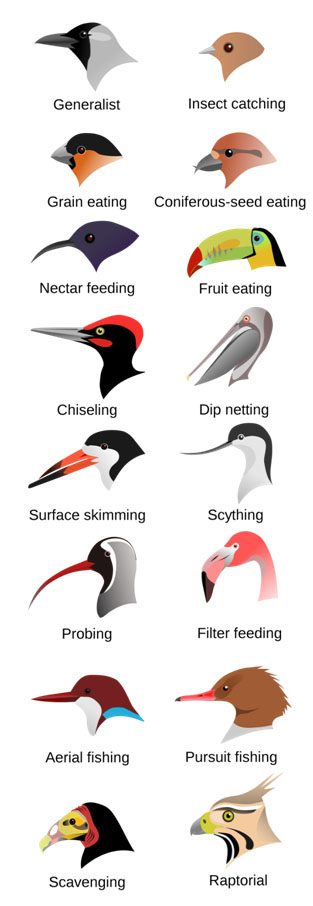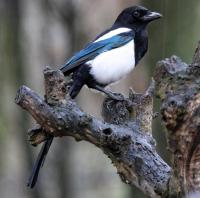- Home
- FAQs
- Customer Video Gallery
- Customer Photo Gallery
- Bird Facts
- Bird Food Blog
- Bird Information
- Feeding Advice
- Small Animal Information
- A to Z of Guinea Pigs
- A to Z of Hamsters
- A to Z of Rabbits
- Basic Care for Guinea Pigs
- Basic Care for Hamsters
- Basic Care for Rabbits
- Basic care for Chinchillas
- Basic care for Ferrets
- Basic care for Gerbils
- Basic care for Mice
- Basic care for Rats
- Buying a Healthy Small Animal
- Does your Reptile need a Licence
- Equipment for Ferrets
- Equipment for Hamsters
- Equipment for Mice
- Equipment for your Chinchilla
- Equipment for your Gerbil
- Equipment for your Guinea Pig
- Equipment for your Rabbit
- Keeping a House Rabbit
- Dog Information
- Cat Information
- Customer Information
- Fat Balls
- Suet Pellets
- Straights
- Seed Mixes
- Suet Treats
- Mealworms
- Bird Feeders
- My Account
Bird Beaks
Types of Bird Bills:

There are many types of birds and as a result many types of bills although all share a similar origin, form and function.
A birds bill, or beak to use its more informal name, consists of two mandibles, upper and lower, each of a bone core covered in a horn like sheath of compact epidermal, or skin, cells.
The upper mandible is typically, although not in all species, rigidly attached to the skull such that it does not move, only the lower mandible is free moving and hinges against it.
The image to the right details the most typical variations in bill design and purpose.
Generalist:
Typically a fairly large bill, relative to head size, with a curved upper mandible and a smaller flatter lower mandible usually associated with omnivorous birds such as crows, jays, magpies and other corvids who are opportunistic eaters of a wide range of foods.
Insect Catching:
Perhaps unsurprisingly, birds with this type of bill typically catch insects either in flight or directly from trees, shrubs, plants and even the ground. They are generally pointed and small in size, compared to overall head size, with fairly similar sized upper and lower mandibles.
Grain or Seed Eating:
Finches are the most obvious members with this type of bill, characterised by a broad triangular shape with strong upper and lower mandibles enabling the bird to break into the shells of grains and seeds.
Coniferous-Seed Eating:
This type of bill usually has similar sized upper and lower mandibles with extended tips offset from each other resulting in each mandible crossing over or under the other. These birds, crossbills, are able to use the elongated tips to prise seeds from pine cones.
Nectar Feeding:
Birds that feed on nectar from flowering plants tend have a long, fine bill with a moderate downward curve to it to allow the collection of nectar from the base of the flower. Hummingbirds are perhaps the best known types of bird with this kind of bill.
Fruit Eating:
Birds that eat fruit often have very large bills in relation to head size enabling them to grasp and manipulate large pieces of fruit and break through the outer skin to the soft fruit inside.
Chiselling:
The most common birds with chiselling bills are the woodpeckers. They are relatively long and thin, though very strong, and can be struck against tree trunks or branches at up to 40 times a second. They are used for opening up hollows, getting at subsurface bugs and to signal other birds in the area.
Dip Netting:
These bills are characterised by a long straight upper mandible, often with a small hooked end, and a lower mandible that has been adapted to hold a large fold of skin that can be used like a net to trap fish or crustaceans in a large gulp of water. The water is drained off and the catch is then swallowed. Pelicans are perhaps the best known examples of birds with this type of bill.
Surface Skimming:
Birds that fly just above the surface of the water dipping their bills into the water to catch small fish tend towards this type of bill. The lower mandible is thickened and elongated with the upper mandible curving into it part way down its length. The lower mandible is drawn through the water until it encounters the resistance of food when the upper mandible strikes down to trap the fish or other creature in the bill.
Scything
These bills are used by wading birds in mudflats and other wetlands to catch small insects or other creatures by sweeping the long thin, upturned bill through the surface waters or mud.
Probing:
Probing bills are characterised by a long thin, downward curving shape used by the bird to feed on worms and other small invertebrates in mud or soft ground.
Filter Feeding:
These bills have a strange shape indeed, they tend to have a pronounced almost 90 degree downturn to them with a large bulbous lower mandible. This downward angle allows for the bottom half of the bill to be submerged in water whilst the top half remains in the air. The bird uses this bill to filter out small crustaceans from the water. Flamingos are the most easily recognised species with this type of bill.
Aerial Fishing:
The Kingfisher has this type of long spear like bill, which it uses to catch small fish in a diving flight into the water from above.
Pursuit Fishing:
Some species of aquatic birds chase fish by diving from the surface of a pond, lake, river or sea and catching them in this relatively flat splayed bill.
Scavenging:
Scavenging birds are opportunistic birds that eat from the dead carcasses of animals or other birds. Their bills are quite large with a pronounced hooked end helping to tear flesh from the body. They often have no head feathers around the base of the bill or even on the entire head as in some vultures.
Raptorial:
Birds of prey such as the Sparrowhawk and owls that feed on small mammals or other birds have this type of bill. It is sharply hooked to pierce prey and hold onto it once caught and then is used to tear off pieces for easier feeding.




